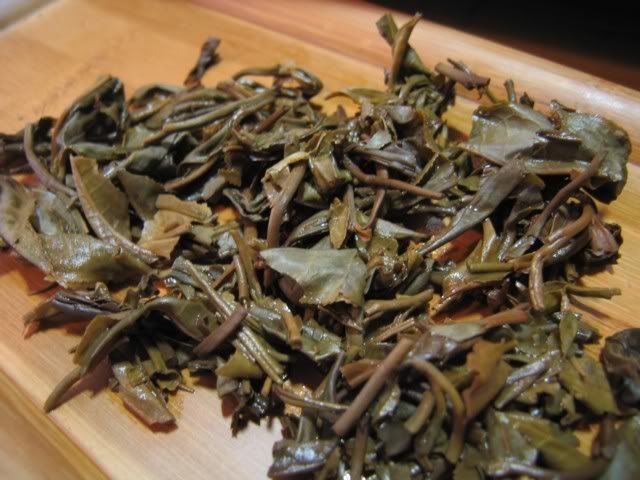One of the wonderful things about having a tea blog is the exchange of information that takes place. I sent out some samples, but I probably get more in return. In fact, I have a feeling that I will always have an endless supply of samples of tea to drink. (By the way, please keep commenting on the samples I sent out — and I have questions for some of you that I posted in the comments section as well).
Since I had Davelcorp’s sample A the other day, I decided to have the sample B today. He told me this is the Fuhai factory 2001 Yiwu Wild Tea. The tea looks quite decent

Last time I drank it, I remembered I liked it better than the Menghai. I have to say I hold the same opinion, although my estimation of this tea has decreased slightly…
The tea as infusions 1, 3, and 7



As you can see…. the colour remains pretty consistent throughout, although that might be a product of my brewing…
The tea is mildly fruity, with a hint, just a hint, of tartness throughout. There’s a pleasant sweetness to the tea, and almost no bitterness whatsoever. It’s lost the Yiwu taste, but what replaced it is something that I don’t normally associate with Yiwu aged a few years. I think storage has to do with this, because Yiwus I’ve had that are aged a few years were stored in Hong Kong, and Hong Kong storage is probably different from Davelcorp’s SF storage, with the tea being lighter and fresher.
The downside that I didn’t notice as much last time was that the tea was a little monotonic, and moreover, a little thin. Not a huge down, and perhaps the brewing vessels/waters changed my impression a little.
Which reminds me… I used 6.6g of tea in my bigger gaiwan (not sure how much water it holds…). Infusions are something like 5, 5, 5, 10, 10, 15, 15, 20, 40, at which point the tea starts dying on me. I’m guessing a little here, but the general point is that… infusions are short. I noticed that parameters vary very wildly among different people who got my samples. Since I have requested people to give me some idea as to how they’re brewing the tea, I should tell you how I brew mine. Generally speaking, I use a relatively (so it seems) high amount of leaves, but doing it in very short infusions. I find this to minimize astringency, generally speaking, and also avoids overly harsh bitterness. The longer the tea sits in water, the more bitter the tea will get and the rougher the tea becomes. In younger raw puerh, it could completely swamp out other flavours sometimes, as I’ve discovered before.
Anyway…. the wet leaves are nice, although a little easy to bruise and break for some reason. Not sure why. Perhaps a few years of rotting did a number on them, but they do appear slightly thin.


All in all though, not a bad tea, and I won’t mind drinking this now. I’m not sure how well it will age into the future, as it is already showing a little weakness. Pleasant enough 🙂

0 responses so far ↓
There are no comments yet...Kick things off by filling out the form below.